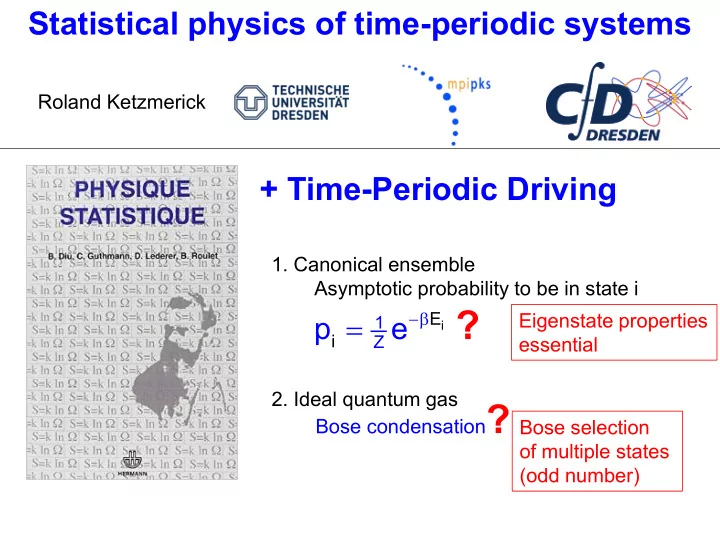

Statistical physics of time-periodic systems Roland Ketzmerick + Time-Periodic Driving 1. Canonical ensemble Asymptotic probability to be in state i ? −β = E Eigenstate properties p e 1 i i Z essential 2. Ideal quantum gas Bose condensation ? Bose selection of multiple states (odd number)
Equilibrium vs. Non-Equilibrium Steady States X X driving heat heat system system bath bath p p q q
Equilibrium vs. Non-Equilibrium Steady States driving heat heat system system bath bath p p q q
Weak coupling to heat bath = + γ + H H H H γ 1 system coupl bath • Reduced density operator M = ∑ ρ j p • Steady state: i i ∞ i (diagonal in eigenstates) = i 1 R j i M ∑ = − = • Master equation: p (R p R p ) 0 i i i j j j i i = j 1 • Floquet-Born-Markov Approach driving heat system Blümel et al.; PRA 1991 bath Kohler, Dittrich, Hänggi; PRE 1997 Breuer et al.; PRE 2000 Kohn; J. Stat. Phys. 2001 Hone, RK, Kohn; PRE 2009 Langemeyer, Holthaus; PRE 2014
Rates 2 = γ ⋅ ⋅ − 2 R j H i g (E E ) τ j i coupl j i coupling strength coupling matrix bath correlation function element driving heat system bath ω m 2 T = ∑ ∫ m − ω R R = γ ε − ε − ω m 2 i m t R dt e u (t) H u (t) g ( m ) 1 j i j i τ j i T j cou p l i j i m 0
2 π p 2 Quartic Oscillator: = + + ω = ω 4 H(x,p,t) x T A xcos( t) 2 p p = t 0,T,2T, x x = ω = A 0.2 0.83 Semiclassical Eigenfunction Hypothesis Percival 1973 Berry 1977 regular chaotic regular ⇒ R Floquet-Born-Markov Approach j i
RK, Wustmann Occupation Probabilities: Quartic Oscillator PRE 2010 M ( ) ∑ − = R p R p 0 i j j j i i = j 1 p i R j i < > E i
RK, Wustmann Occupation Probabilities: Kicked Rotor PRE 2010 p p i i = K 2.9 R < > E j i i < > E i
RK, Wustmann Occupation Probabilities: Kicked Rotor PRE 2010 = K 2.35 ⇒ Eigenstate properties essential
… on to many-body systems … Many-body + periodic driving (no heat bath) Experiment: Tomkovic, Müssel, Oberthaler Theory: Schlagheck, Löck, R.K. • Poincare-Birkhoff scenario N=700 • Spreading in regular vs. chaotic region
Vorberg, Wustmann, R.K., Eckardt, PRL 2013 Generalization of Bose-Einstein Condensation in Non-Equilibrium Steady States Bose-Einstein Condensation Bose Selection Which states? ground n n How many? i i state odd N N André Eckardt
Weak coupling to heat bath = + γ + H H H H γ 1 system coupl bath • Reduced density operator M = ∑ ρ j p • Steady state: i i ∞ i (diagonal in eigenstates) = i 1 R j i M ∑ = − = • Master equation: p (R p R p ) 0 i i i j j j i i = j 1 Ideal Bose gas: = n (n , , n , , n , ,n ) j 1 i j M ( ) M + R n (n 1) ∑ = − + = p R p R p n (n 1) 0 j i i j i j j i i j n n n i ji = i , j 1 quantum statistics solution: exists, unique
Occupation of single particle states (mean-field approximation) M ∑ = + − + = n R n (n 1) R n (n 1) 0 i i j j i j i i j = j 1 → ∞ n Asymptotic theory for : Zero determinant of − Odd number M S of states selected R R antisymmetric matrix ji i j when dimension odd. Which states selected? • existence and uniqueness (H. Schomerus) • algorithm • M S =1 (Bose condensation) iff > R R „ground state“ k with for all i ki i k otherwise M S ≥ 3
R Random rate matrix: from exponential distribution j i mean occupation n i = M 200 = M 10 = n N M n + quantum jump Monte-Carlo simulation ─ mean field approximation
Examples for Bose selection Periodically driven quartic oscillator Kicked rotor K=10
Examples for Bose selection Tight-Binding Chain (10 sites): periodically driven N=10000 driving strength always M S ≤ 3 ! R j i
Examples for Bose selection Tight-Binding Chain (10 sites): 2 baths N=10000 ↑ relative bath coupling ↑ only bath 1 only bath 2 ⇒ Quantum switch for heat
+ Time-Periodic Driving 1. Canonical ensemble Asymptotic probability to be in state i ? −β = E Eigenstate properties p e 1 i i Z essential 2. Ideal quantum gas Bose condensation ? Bose selection of multiple states (odd number) Open directions: ⇒ anomalous long-range order in 1D (A. Schnell) ⇒ particle reservoir gives even number (D. Vorberg) - interaction - experiment (cold atom, quantum dot) - connection to lasers (J. Wiersig)
Recommend
More recommend